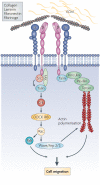Integrins in angiogenesis and lymphangiogenesis
- PMID: 18497750
- PMCID: PMC2577722
- DOI: 10.1038/nrc2353
Integrins in angiogenesis and lymphangiogenesis
Abstract
Blood vessels promote tumour growth, and both blood and lymphatic vessels facilitate tumour metastasis by serving as conduits for the transport of tumour cells to new sites. Angiogenesis and lymphangiogenesis are regulated by integrins, which are members of a family of cell surface receptors whose ligands are extracellular matrix proteins and immunoglobulin superfamily molecules. Select integrins promote endothelial cell migration and survival during angiogenesis and lymphangiogenesis, whereas other integrins promote pro-angiogenic macrophage trafficking to tumours. Several integrin-targeted therapeutic agents are currently in clinical trials for cancer therapy. Here, we review the evidence implicating integrins as a family of fundamental regulators of angiogenesis and lymphangiogenesis.
Figures




References
-
- Carmeliet P. Angiogenesis in life, disease and medicine. Nature. 2005;42:932–936. - PubMed
-
- Adams RH, Alitalo K. Molecular regulation of angiogenesis and lymphangiogenesis. Nat. Rev. Mol. Cell Biol. 2007;8:464–478. - PubMed
-
-
Lyden D, et al. Impaired recruitment of bone-marrow-derived endothelial and hematopoietic precursor cells blocks tumor angiogenesis and growth. Nat. Med. 2001;11:1194–1201.This article established the concept that bone marrow derived cells in lung and other tissues could help create an environment that attracts metastatic tumor cells.
-
-
-
Lin EY, Pollard JW. Tumor-associated macrophages press the angiogenic switch in breast cancer. Cancer Res. 2007;67:5064–5066.This article shows that macrophages play critical roles in altering the fate of tumors by secreting pro-angiogenic growth factors.
-
Publication types
MeSH terms
Substances
Grants and funding
LinkOut - more resources
Full Text Sources
Other Literature Sources

